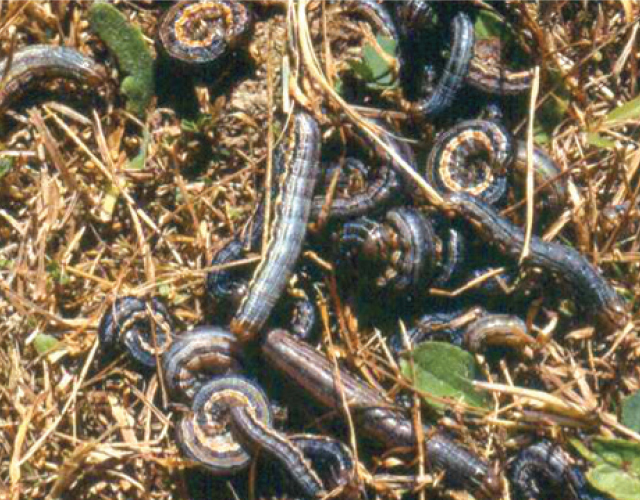
The fall armyworm is known to destroy over 70 percent of the crop it invades
Jeffrey Gogo Climate Story
THE Food and Agriculture Organisation (FAO) is to spend millions of dollars acquiring specialised trap kits to control the spread of the fall armyworm, an invasive American moth that has caused some crop damage on farmlands across southern Africa.
“FAO has initiated the process of procuring pheromone insect lure traps which are used for capturing armyworm and monitoring their spread,” said Leonard Makombe, the agency’s spokesperson, in an emailed statement.
Mr Makombe did not specify the amount of money to be spent on the project. The snares are to be distributed in all affected countries, some of which have yet to assess the full extent of the attack due to a lack of capacity.
Pheromone, an airborne chemical that attracts animals of like species to the extent of altering their behaviour and physiology, according to the know-it-all online dictionary, Wikipedia, is seen as a potential long-term strategy for bringing the fall armyworm under control.
The worm – quick on flight, not easily detectable and difficult to control – has now spread across seven southern African countries since it was first noticed early January, says FAO, causing nightmares for both governments and farmers.
In Zimbabwe, the worm has invaded 130 000 hectares of cropland, targeting its favourite prey, maize. Insectrcides are used for control.
Zambian farmers have been forced to replant crops after nearly 90 000ha of maize was decimated, officials say.
In Malawi some 17 000ha have so far been affected while in Namibia, approximately 50 000ha of maize and millet has been damaged.
The greatest headache is from the fact that the fall armyworm is a first time attacker in this part of the world.
As such, there has been a lack of information and knowledge on the most effective ways of curbing the spread of a pest that eats everything in its way – from leaf to cob to stalk, including competitors.
Regular contact pesticides used to deal with the more familiar African armyworm or the stalk borer have yielded undesirable results, forcing some small farmers to turn to unorthodox control measures including the application of washing powder onto the funnel of the maize crop. There are reports of some success in this regard, but insect specialists here aren’t pleased.
“ . . . we are very concerned with the emergence, intensity and spread of the pest (fall armyworm),” said David Phiri, FAO sub-regional coordinator for southern Africa, at an emergency Sadc meeting held in Harare two weeks back, to deal with runaway crop pests like the fall armyworm.
Phiri is worried that the scale of economic impact from uncontrolled pest infestations could be staggering for individual Sadc nations, as well as the region as a whole. And he knows it all too well.
“It is only a matter of time before most of the region will be affected, and the costs and implications of this are very serious, as seen in places where fall armyworm is endemic such as Brazil, where the government spends in excess of $600 million each year to try to control infestations,” he cautioned.
FAO said it will support Sadc countries with expertise and funding to close gaps on early warning, response, information dissemination and scientific research, which have impeded understanding of the fall armyworm and its effective control.
Climate Impact
Climate change, and global trade, have fuelled an escalation in the spread of crop-damaging pests such as fungi and moths, which have advanced into new territories faster than other wildlife, according to a 2013 report in the journal Nature Climate Change.
In the last 50 years, insects have expanded their range by dozens of kilometres a year, scientists say.
In its native America, the fall armyworm travels up to 2 000km each year in search of warmer climates. In this respect, southern Africa is a haven.
“Climate change triggers or awakens hibernating pests with potent economic damage level,” Pasipamire Wesa, a crop protection specialist with Introlab Zimbabwe, an agriculture chemical research firm, told The Herald Business.
Wesa said while information on the fall armyworm remained sketchy, the pest exhibited similar feeding characteristics with those of the cotton red bollworm and the maize stalk borer that can both be tough to control chemically.
Yet still, it can be done through integrated approaches.
The bollworm burrows into the fruit, and the stalk borer enters the maize crop via the funnel and feeds on the stem and cob.
There is just one problem: “There is a serious gap between the farming community and the agrochemical industry,” Wesa complained.
“The agro-chemical industry is abreast of technological innovations in crop protection.
However, the industry is undermined by decision makers in various sectors of farming. Most of the decision makers stampede authority and assume crop protection knowledge and advice wrongly to the farming community.”
No comment could be immediately obtained from Government agriculture officials.
But scientists at the UK-based Centre for Agriculture and Biosciences International, an 48-member country research organisation, say it could be years before an effective control method for the fall armyworm is found.
The fall armyworm pest is known to destroy over 70 percent of the crop it invades. Authorities here say it has spread to nearly all the country’s ten provinces.
The Government maintains that food security is not under threat, particularly so in a season it expects to harvests more than two million tonnes of the maize staple following a drought last summer.
God is faithful.
